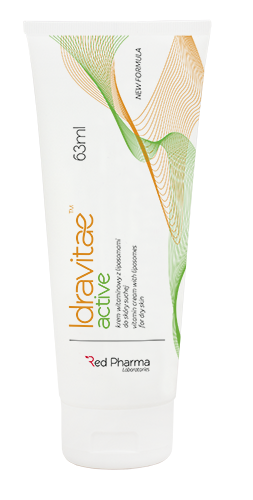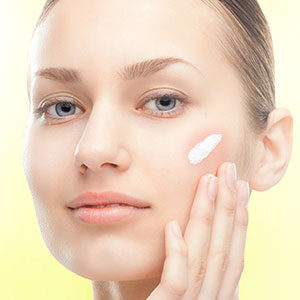
Idravitae™ active, 63ml
multi-vitamin cream with liposomes for dry skin
Repeated temperature changes, heating and dry indoor air in winter, overzealous body washing, especially in summer, damage the skin’s protective barrier and disrupt its pH. Consequently, the skin becomes dry, scaly, and itchy.
Human skin naturally has an acid pH, an average pH of 5.5, and this medium enables the protective barrier and protective bacteria to be maintained. Because of external factors, as well as shower gels, soaps, and detergents, which have an alkaline pH of 9-12, the skin has to change its medium from acidic to alkaline. It causes skin damage. Protective bacteria are killed and replaced with pathogenic bacteria. The skin loses its tightness, elasticity, becomes dehydrated, over dried and susceptible to infections. Also, persistent itching may appear.
Patients wanting to help themselves try to use various generally available creams and emollients, although most of them have a neutral pH the same as, for example, water. The usage of pH-neutral products does not cause permanent improvement, since they do not restore the correct, natural, acidic skin pH of 5.5. To achieve this acidic pH, it is necessary to use hand-selected ingredients, adjust the process and quality of production, and use suitable machines that would allow us to create unique products with acidic pH. Idravitae products contain lactic acid, which can naturally reproduce an acid pH of 5.5, which is able to restore the skin’s protective barrier, reduce the number of pathogenic bacteria, and moisturize and oil the skin to prevent water loss.
Liposomes are microscopic balls smaller than 200 nanometres, containing active ingredients (in Idravitae active it is vitamin C), which are used to carry them into the deep layers of skin. Liposome membranes have multiple layers. Water-soluble active substances (hydrophilic), such as collagen and plant extracts, are contained inside the liposome, while fat-soluble substances (lipophilic), e.g. some vitamins and vegetable oils, are placed in the outer lipid layer. Placing the active substances in liposomes is very complex and requires the usage of an appropriate technological process. Liposome stability in a product is one of the most important things and is guaranteed by hand-picked recipes, elaborate raw materials and a special production method.
The active substances contained in the liposomes can be transported into the deep layers of the skin and be absorbed more quickly. Liposome membranes dissolve in the skin, slowly releasing the active substances. It means the skin absorbs the nutrients better and more effectively than ordinary creams and lotions.
What does vitamin A do for your skin?
Vitamin A is essential in the process of epidermal stem cell regeneration. It improves the structure and function of the stratum corneum, strengthens the skin’s protective barrier, prevents drying (water loss), and supports the process of epidermal keratinisation (exfoliation). It reduces pigmentation and spots as well as prevents skin ageing. Vitamin A benefits water-fat balance, which reduces skin roughness and desquamation.
What does vitamin E do for your skin?
Vitamin E is called the vitamin of youth because of its antioxidant properties, which enable the process of free radical neutralization. It infiltrates the skin, becoming a part of the epidermis and cell membrane structure by which it is able to protect the lipid layer from damage and oxidation. What is more, it prevents drying and inflammation, reduces redness and swelling caused by UV light, supports collagen production, soothes and moisturizes the skin, and improves its elasticity. Vitamin E is an antioxidant, which means that it protects the skin from signs of ageing such as facial and hand discolouration.
What does vitamin C do for your skin?
Liposomes in the liposomal form of vitamin C are used to directly transfer its active form deep into the skin, which means that it can be absorbed much better. Vitamin C protects the skin from the damage caused by free radicals and supports the process of collagen synthesis, which is responsible for skin elasticity. It improves the condition of fragile and rupture-prone blood vessels (it is very important for couperose and sensitive skin), enhances the skin colour, smoothes and gives it a natural glow.
Aktywne składniki:
Jak działa na skórę witamina A:
- jest niezbędna do regeneracji komórek w warstwie podstawnej naskórka;
- poprawia strukturę warstwy rogowej, a tym samym wzmacnia funkcje obronne skóry i zapobiega wysuszeniu skóry (utracie wody);
- zmniejsza przebarwienia i plamy;
- zapobiega starzeniu się skóry;
- reguluje procesy keratynizacji naskórka;
- wywiera znaczący wpływ na równowagę wodno-tłuszczową, dzięki czemu ogranicza szorstkość i złuszczanie naskórka.
Witamina C w liposomach:
Dzięki specjalnym nośnikom – liposomom , aktywna postać witaminy C jest przenoszona odpowiednio w głąb naskórka, przez co jest lepiej wchłaniana.
- chroni przed niszczącym działaniem wolnych rodników. Jest to szczególnie ważne dla osób mieszkających w dużych miastach, gdyż pod wpływem zanieczyszczeń w atmosferze uwalniają się one w dużej ilości;
- wywiera korzystny wpływ na syntezę kolagenu, odpowiedzialnego za elastyczność i sprężystość skóry;
- poprawia stan kruchych i skłonnych do pękania naczyń krwionośnych (bardzo istotne dla skór bardzo unaczynionych i wrażliwych);
- odgrywa bardzo ważną rolę w przebiegu metabolicznych skóry;
- poprawia koloryt, gładkość i blask skóry.
Jak działa witamina E na skórę:
- ma zdolność neutralizowania wolnych rodników, wbudowuje się w warstwy naskórka i struktury błon komórkowych, chroniąc przed utlenieniem i zniszczeniem warstwę lipidową naskórka;
- zapobiega wysuszeniu skóry i powstawaniu stanów zapalnych;
- zmniejsza rumień i obrzęk spowodowany promieniowaniem ultrafioletowym;
- sprzyja tworzeniu kolagenu, poprawia elastyczność, wygładza i nawilża skórę;
- przeciwdziała zmianom starczym, czyli przebarwień skóry, najczęściej pojawiających się na twarzy i dłoniach.
Application:
- nutrition and care for dry, over-dry, cracked, exfoliating skin;
- it oils and regenerates damaged epidermis;
- in psoriatic changes;
- rough skin;
- skin regeneration after steroid and antibiotic therapy;
- in atopic changes of the skin.
Use:
Apply a thin layer of cream onto previously cleansed and dried skin, smear, and leave to absorb. Best results are achieved when applied twice a day.






